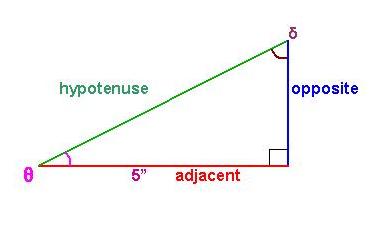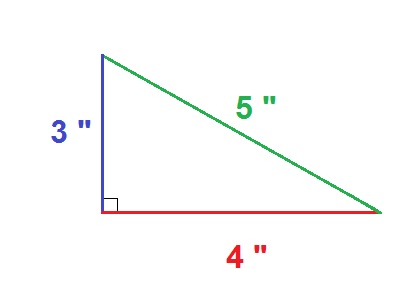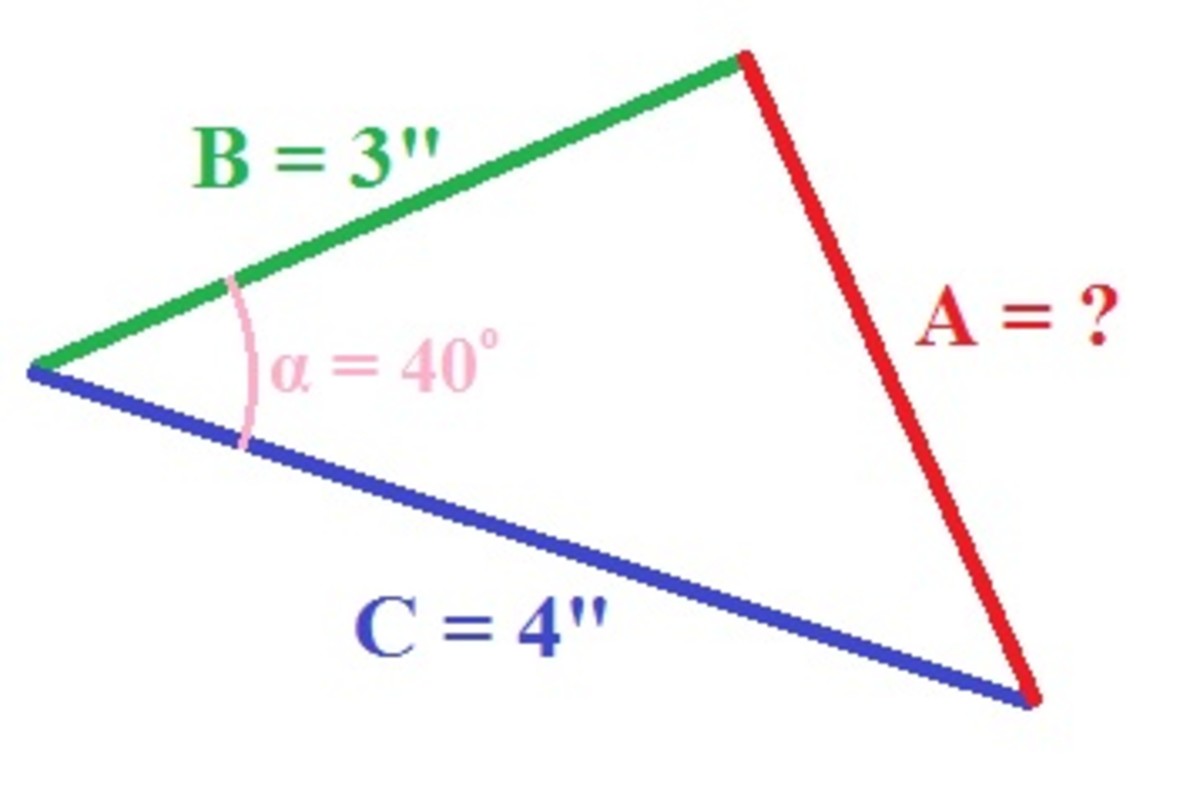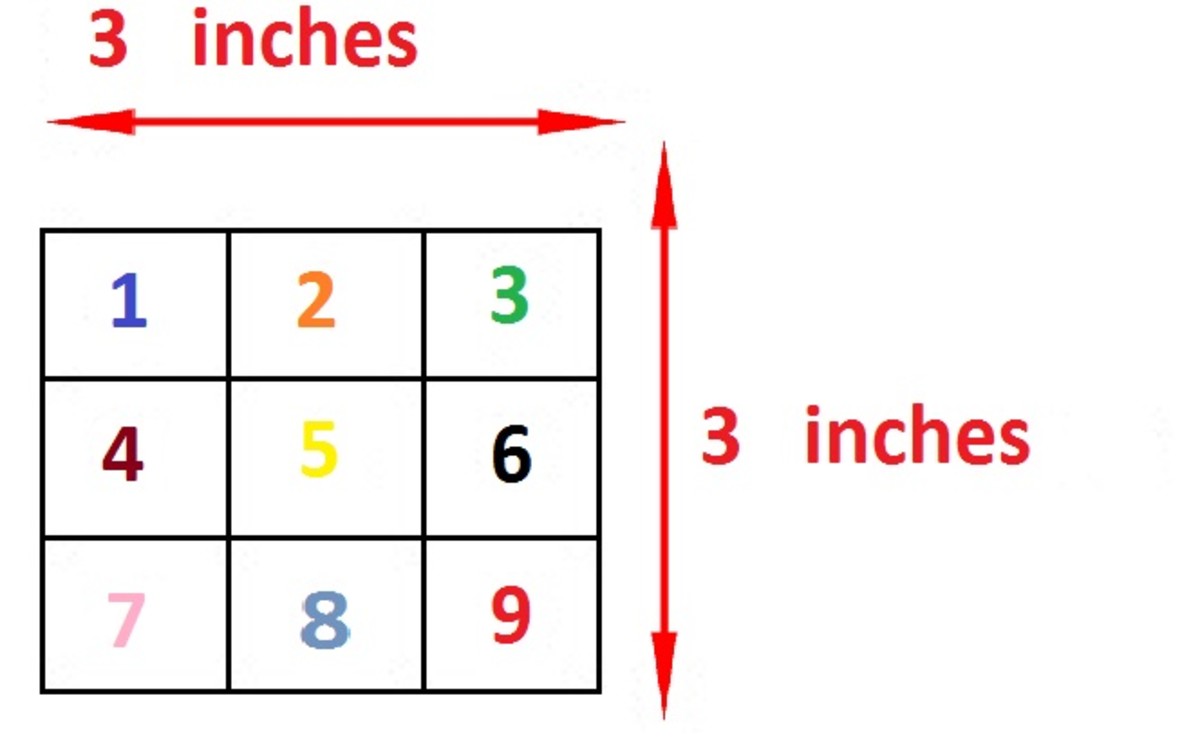Trigonometry to Begin With
Trickonemetry Rules !
Having an introduction into the World of Shapes in The Shape of Things to Come, let us now have a better look at Geometry and its related topics, which themselves form a large part of the study of Mathematics.
First, but by no means easiest, I would like to sneak a quick detour to that one subject which floors many hardworking students : Trigonometry.
The reason for our short look at this, is that we shall be using some of it for other related topics, so let us now refresh our memories. You may or may not have done this kind of thing before, but once you get the hang of it, it isn’t so hard, and the main thing is understanding what it all means.
What it Rules
Trigonometry especially involves the study of right angled triangles, as well as Circular Functions which are graphed as Waves, and other kinds of curves, but we won’t concern ourselves with that branch of the subject as yet. In any Triangle, the internal angles all add up to 180 degrees, so if one of them is at ninety, the sum of the other two angles add up to the other ninety.
The ancient Greeks studied Shapes in particular - as opposed to the Arabs’ fascination with Numbers and Letters - and they eventually worked out that, according to the size of the other two smaller internal angles, there was a relationship between the lengths of the sides of the Triangle. Now these relationships are always the same regardless of the size of the Triangle, as long as the angles within the Triangle are identical to those within the Triangle of the other size, where we say they are Similar Triangles.
Once again, just so we can see what is being meant, let us draw ourselves a little picture, to make the whole thing that much clearer :

What the above Diagram means
If you look at the Triangle, we concern ourselves with the angle at the bottom left, marked by the Greek letter theta ( θ ), as is the custom. With respect to this angle only, the right hand vertical side is its Opposite, the bottom edge ( base of the triangle ), is its Adjacent, while the longest side is always the Hypotenuse.
Let us say that the angle θ is equal to 30°, so in order for it and the other angle to both add up to ninety, then this other angle, denoted here as delta ( δ ), has to equal 60°. The idea behind the three main Trigonometric Functions ( Sine, Cosine and Tangent ), is that they give us a ratio of the lengths of the sides - that is, they tell us how much longer one side is to the other, depending on the size of the angle.
Let us then decide to compare the sides. We shall say that the base of this Triangle is five inches in length. From just this, we can actually work out the lengths of the other two sides.
The base, in relation to the angle we shall use, θ, which is 30°, is its Adjacent side, so we need to use a function involving the Adjacent. Our three main functions are :
Sine = Opposite divided by Hypotenuse
Cosine = Adjacent divided by Hypotenuse
Tangent = Opposite divided by Adjacent
The choice of function is determined by which length you want to find. Say I would like to know how long the Hypotenuse is. Since I already know the Adjacent, which equals five inches, the obvious one to choose is the Cosine, as this will tell me what decimal fraction in length the Adjacent is to the Hypotenuse.
Knowing one side, an Example to work out the second side of the Triangle
What we do now, is either get out our Trig tables, or plug into our calculator the following : Cos 30 = and we get the following answer : .866 ( rounded down to 3 decimal places ). This tells us that the five inch length of the base of the Triangle is .866 times that of the length of the Hypotenuse.
Now this means that if we knew this Hypotenuse, all we need do is multiply it by .866 to find the length of the Adjacent, but seeing it is the other way round ( we know the Adjacent, and wish to find the Hypotenuse ), we do the opposite, and divide five inches by .866. This gives us 5.7735 " , ( rounded down to four decimal places ), which means that if the Adjacent side to an angle of 30° is five inches, then the Hypotenuse will be 5.7735 inches. You can also check this by multiplying 5.7735 by .866 to get back to five inches, to confirm that five is .866 of 5.7735.
Example to find the third side of the Triangle
This leaves us with the third side of the Triangle- the length of the edge opposite the angle of 30°. Knowing the other two, we can now work out this third length a number of ways. First of all, let us see how this side relates to our Adjacent base of five inches. Now if we know the Adjacent, and want to find the Opposite, the obvious function to use is the Tangent, since as we know this is ratio of the length of the Opposite side divided by that of the Adjacent. What we can say here, is that the Tangent of thirty degrees equals the length of the Opposite, divided by five, or, that the length of the Opposite is equal to five times the Tangent of 30°.
Tan 30 = .57735. Well, that is interesting, because we have seen something like that number before ! This is because all of this is in some way interconnected, which we shall see.
And, 5 tan 30 = 2.887 ( rounded up to 3 d.p. )
This tells us that the relation between the Opposite and Adjacent of two sides meeting at an angle of thirty degrees, is that the Opposite is just over half ( .5 ) of the length of the Adjacent. Half of five inches is two and a half inches, and 2.887 is just above that.
How do sides relate ?
Now, even though we don’t need to, seeing we now have the lengths of all three sides, let us see how the Opposite relates to the Hypotenuse. The function that does this is the Sine, which is the ratio we get when we divide the Opposite by the Hypotenuse. The sine of 30° equals .5, so what this tells us, is, that with respect to an angle of thirty degrees, the length of the Opposite is exactly .5, or half that of the Hypotenuse. 2.887 × 2 = 5.774 ( remember that these numbers have been rounded up and down, so sometimes we get a bit of a rounding error )
But some Ratios do have their Limitations
It is also needful to be aware, that both Cosine and Sine never reach a value above one, but Tangent can be any value. Also, if two angles add up to ninety degrees, the Sine of one is the Cosine of the other, so that Sine 30 = Cosine 60, and so forth. Also, it is useful to know that the largest angle is always opposite the longest side, and so the longer the side opposite a given angle, the greater that angle will be, and consequently, the greater the angle, the larger the side opposite it can be.
This stands to reason, if you imagine an angle acting like a kind of hinge - just as a door does - and this is the same sort of thing, which gives doors their usefulness. As you open a door, the gap between it and the door jamb closest to where the handle is when the door is shut, increases so that you can step through. But also, the angle formed at the door hinge end also increases.
Basically, the Trigonometric Ratios, i.e., Tangent, Cosine and Sine are used to find angles if you know lengths, and lengths if you know angles. If you know all three lengths, then you can find all the angles, but knowing all the angles won’t necessarily give you any of the lengths if you have no scale to work with, which is the principle behind Similar Triangles. To scale such a Triangle, therefore, You need at least one length, but once You have that length, with all three angles, You can then work out all of the rest.
It's all Greek to Some
As to these lengths, we know that for Right Angled Triangles, Pythgoras’ Theorem holds true. We shall tackle him in the next Hub, as what he teaches us relates to Trigonometry, The most basic of these Triangles, that is, the one with the shortest whole number values, where all three sides are whole numbers, is the 3 : 4 : 5 triangle, where 3² + 4² = 5².
When I worked at a box factory here in Christchurch around 2006, one of the workers there told me that the way they used to construct a Right Angle was to build a Triangle with exactly these three measurements, (i.e., the 3 : 4 : 5 triangle), since you knew that if you used these exact ones, one of the angles would definitely be ninety degrees, which they may need to build upright walls, or any other such thing.
Now, knowing all three of these sides, we can actually work out its interior angles. One of them, the largest, opposite the side that has a length of five, is 90°. Let us draw the Triangle to see what we mean :

Working out Angles of the 3 - 4 - 5
So let us now say we want the top angle, opposite the side that is four inches long. This will be the middle sized angle, and if we look, we see that if we take its Opposite ( = 4 ), and divide this by the Hypotenuse ( = 5 ), and from before we understand that Opposite ÷ Hypotenuse = Sine, and 4 ÷ 5 = .8. So what we do is use our calculator to find the angle that has a Sine equal to .8.
This we do by locating the Arcus Sine Function button. This is the button falsely symbolised by sin -1 on the calculator, which is carried out, depending on what type of machine you have, by some Inverse Function of the normal Sine button. So, Arcus Sine ( .8 ) = 53.13°. That is to say, the Arcus Functions of Sine, Cosine and Tangent are always angles - once again, the angles that You would have, whose Sine, Cosine or Tangent, respectively, take the value given, for example here, just to be clear, that if the value is .8, then .8 is the Sine of some angle, and by using the Arcus Function, we are trying to find the angle that .8 is the Sine of. Thus from this answer, if the angle that .8 is the Sine of is 53.13°, we can logically say that Sine ( 53.13°) = .8.
Next, we could work the other angle out in a similar fashion, or we realise, that this answer and our third angle add up to ninety, so we subtract 53.13° from 90°, to get 36.87°, or we do both to verify it - we add them up, then we also find the Arcus Sine value of .6, or the Arcus Cosine of .8, and all three values should correspond.
Now in terms of whole numbers, there are only a select few that work, so that the sum of the squares of the lesser two equal the square of the Hypotenuse. But if we were to multiply each of our lengths in the 3 : 4 : 5 triangle by the same number, we would end up with another Right Angled Triangle.
To Conclude
For right angled triangles, there are two separate but very closely related topics, Trigonometry, which we have just had a good look at, and to come, Pythagoras' Theorem, where we in particular shall look at the concept touched upon here with the 3:4:5 triangle, which is that of the Pythagorean Triplet.
Disclaimer
As much as some of this Hub contains certain Mathematical knowledge accessible in the public domain, and not subject to any Copyright, other information has been drawn from textbooks which themselves are Copyright, but only in the sense of how they deliver the information which itself is shared and sometimes ancient Mathematical knowledge. Other information has also been found on Wikipedia ( Copyright 2013, the Wikimedia Foundation ), which is a good source of information. Part of this is also my own discovery, but may also independently have been found by others.
The term Trickonometry was, to my knowledge, invented by me, as a play on the words Trick and Trigonometry, in that this subject can indeed become quite tricky. With care and hard work, it can however be mastered. The quote about knowing one's Limitations can be seen to have been paraphrased from Dirty Harry's comments in the Movie Magnum Force ( 1973 ), but I am not sure if that is where I took it from. The It's all Greek to some quote is from Act One, Scene Two of Shakespeare's Julius Caesar, with Casca speaking to Cassius about what Cicero had said.
All illustrations in this particular Hub are my own, and have primarily been done using Microsoft™ Paintbox, by editing diagrams done originally on Microsoft™ Word. Any quote or part of this material which seems to belong to any other author should be treated as such, and I claim no ownership of anything I did not myself invent or discover, nor of any obvious copyright, trade mark, or registered trade mark.
The Adventure continues in the next Hub Pythagorean Theorem and Triplets,
If You are curious, then by all means do take a look at the other Hubs, The Maths They Never Taught Us - Part One, The Maths They Never Taught Us - Part Two , The Maths They Never Taught Us - Part Three, The Very Next Step - Squares and the Power of Two , And then there were Three - a Study on Cubes, Moving on to Higher Powers - a First look at Exponents, The Power of Many More - more on the Use of Exponents, Mathematics - the Science of Patterns , More on the Patterns of Maths , Mathematics of Cricket , The Shape of Things to Come , Things to do with Shapes, Pyramids - How to find their Height and Volume, How to find the Area of Regular Polygons, The Wonder and Amusement of Triangles - Part One, The Wonder and Amusement of Triangles - Part Two, the Law of Missing Lengths, The Wonder and Amusement of Triangles – Part Three : the Sine Rule, and The Wonder and Amusement of Triangles - Part Four : the Cosine Rule.
Also, feel free to check out my non Maths Hubs :
Bartholomew Webb , They Came and The Great New Zealand Flag
Just take a good look at it, and note how interesting it all is, then see if you can come up with anything else along the same lines. As usual, I would appreciate any comments, feedback and suggestions which would be given due credit, or indeed have a go and publishing Your ideas Yourselves, but firstly, by all means, add Your comments - it's a free Country.





